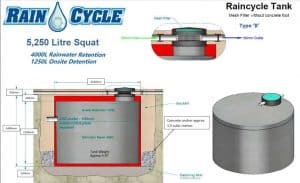Australia, in general as we know, is a hot, dry climate. Freshwater is a valuable yet limited commodity in the region. According to the Australian Bureau of Statistics in 2001, more than 90% of Australians get their domestic water supply from mains water; however, some vast areas with low population densities have few reticulated supplies. Thus, in order to survive, people in these areas look for other local sources of water like rainwater collected in water tanks NSW. So, how do rainwater tank works?

Rainwater Harvesting
Rainwater harvesting, from the term itself, means collecting rainwater through rainwater tanks Sydney. Rainwater is a valuable natural resource of water that can be used for non-drinking purposes in the household such as washing clothes, car, etc., toilet flushing, and watering plants. It can also be used to supply water in swimming pools and spas and water heating systems.
There are 4 different types of rainwater tanks according to the material used. These are:
- Concrete rainwater tanks- these tanks are made of concrete and can either be built above or in-ground as these have load-bearing lids. These tanks are durable and long-lasting. Plus, these tanks prevent algal growth as light cannot penetrate inside it and keep the water inside cool.
- Plastic or Polyethylene tanks- these tanks are made of durable polyethylene plastics which are known to be durable, lightweight, and UV-resistant. Like concrete, plastic tanks are either placed below or above the ground.
- Steel tanks- tanks made of the metallic Steel are robust and durable. They are light and easy to transport and can be installed below or above the ground.
- Fiberglass tanks- tanks made of fiberglass are long-lasting as they are resistant to chemical corrosion and rust and can tolerate extreme temperatures. These come in a large range of colors, shapes, and sizes and are generally lightweight. These are best installed above the ground.

Benefits of collecting rainwater through tanks
Aside from the fact that it is a good alternative to increase water supply especially in the regions North and mid-North Coast, South Coast, Southern Highlands, and other areas in NSW, here are the reasons people should get water tanks:
- Reduce water bills
- Protect the remaining natural sources of water
- Reduce operating costs on infrastructure
- Lessen the need for new desalination plants or dams
How does it work?
This is how water tanks simply work:
- First, rainwater is collected on a catchment area usually from the roof where it is then funneled to the gutters.
- Then, it flows water to the pipes and into the tank.
- Next, a pump pulls water out from the cistern via a small pipe.
- Then, the water passes through a filter.
- Afterward, it enters into the pressure tank, which gives sufficient water pressure to the fixtures inside the house.
Conclusion:
The NSW Health supports the utilization of water tanks NSW such as concrete rainwater tanks in collecting rainwater for non-drinking purposes. The use of rainwater helps preserve the public water supply and reduces stormwater impacts. No matter how you intend to use the water collected through these rainwater tanks, it is crucial to ensure that you collect and store them as cleanly as possible. Rain harvesting will not only help you reduce your water bills but will also let you save mother earth in your own little way. If you looking for a quote or more information contact Raincycle on 1800 006 176 or contact us at https://raincycle.com.au/contact/





